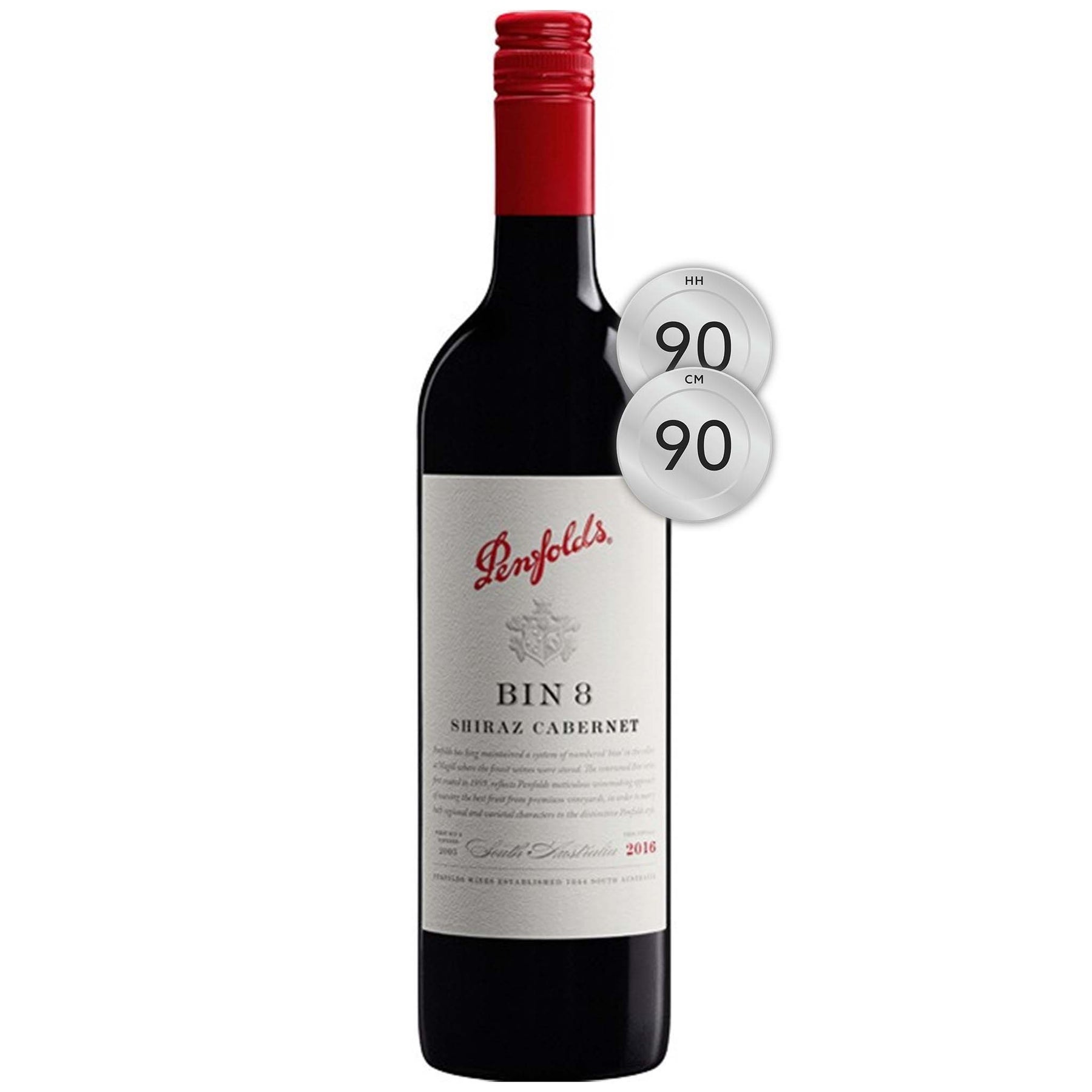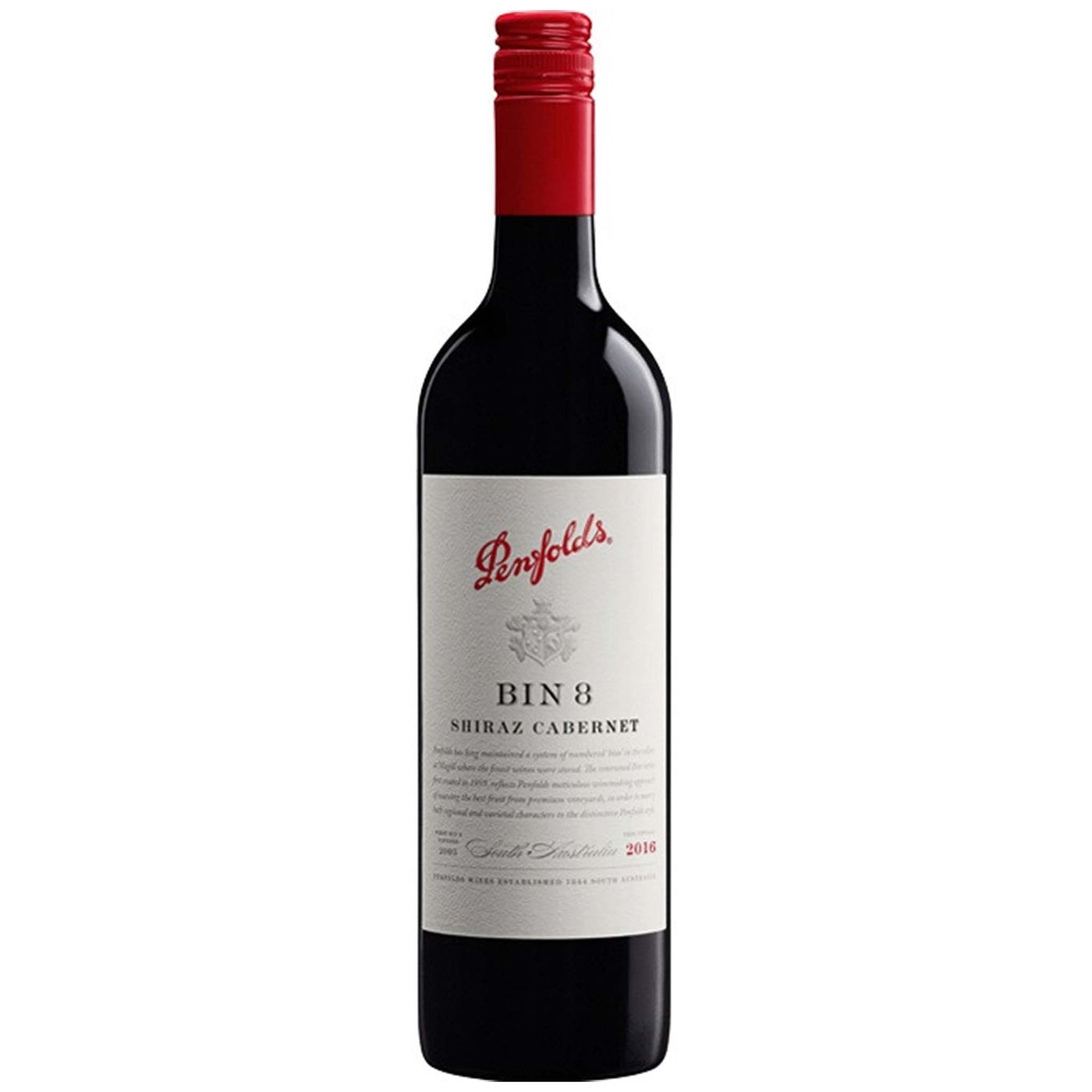

Penfolds Bin 8 Shiraz Cabernet 2016
Style: Red Wine
Varieties: Shiraz (80%), Cabernet Sauvignon (20%)
Closure: Screwcap
Penfolds Bin 8 Shiraz Cabernet 2016
Warehouse
34 Redland Drive
Vermont VIC 3133
Australia
Critic Score: 90
Alcohol: 14.5%
Size: 750 ml
Drink by: 2031
Bin 8 has been crafted in the traditional Penfolds style. Ripe, balanced fruit flavours are supported by softly integrated oak resulting in an impressive, smooth red wine. It was introduced in response to a heightened interest in shiraz and cabernet blends – a classic Australian wine style that caught the attention of the international wine media. Although Bin numbers were originally named after the original Bin location after bottling, Bin 8 was given its number because it uses older oak previously used for Bin 128, Bin 28 and Bin 389 – with '8' obviously providing the common thread.
"The bouquet is plummy and ripe, fruit-driven and bold. The palate is medium to full-bodied and savoury, with ample drying tannins and hints of toast from barrel ageing. Abundant soft tannins complete the picture." Huon Hooke
The 2016 Bin 8 Shiraz Cabernet was sourced from vineyards in McLaren Vale, Barossa Valley, Padthaway, Wrattonbully and Robe. The wine was matured for 12 months in French oak and American oak (9% new).
"Nose: Cabernet hallmarks are more prominent than what the composition would suggest ... white pepper, blackberry leaf and punnets of fresh raspberries ascend. Well seasoned carpaccio, brine and sea salt purity…? Red fruits and liquorice, from the Shiraz or the Cabernet? Source unknown! A quintessential Australian blend, yet still "modern” in identity.
Palate: Shiraz foundations emerge with generosity and vinous energy. A steely, graphite core and rhubarb succulence imprint. A defined and focussed structure emerges … a trait that is often mentioned across previous vintages of Bin 8 ... it is at home here! At first the tannin structure is grainy, and becomes powder-like in texture upon sitting in the glass…. Hungarian paprika, pomegranate and berry coulis abound. French and American oak each offer support … contributing to the spice spectrum, binding the palate and ensuring compliant tannins. Peak Drinking: Now-2030.
Vintage conditions: The 2016 South Australian vintage was consistently mild and dry. Winter rainfall and temperatures were significantly lower than the long-term average with Padthaway recording one of the driest years in over seven years. From spring through to late summer, record low rainfall was documented with only late January and February providing some slight relief. A warm start to spring continued into early summer which sped up the grapevine growth after a sluggish start. After a quick start to harvest, a dip in temperature in late summer prolonged the ripening of the later varieties and provided strong development of varietal flavours." Penfolds
Expert reviews
"Deep red colour with a good tint of purple. The bouquet is plummy and ripe, fruit-driven and bold, if a trifle straightforward. The palate is medium to full-bodied and savoury, with ample drying tannins and hints of toast from barrel ageing. Abundant soft tannins complete the picture. Drink: 2017–2031." Huon Hooke, The Real Review - 90 points
"Penfolds first and last. Creamy vanilla, blackberried fruit, a toastiness, a brighter/raspberried lift to the finish. Clovey spice too. It's medium in weight but it promotes a general feeling of substance. The finish isn't silk, it's slightly grainy/scratchy, but it doesn't detract; it works. It's a satisfying red wine, and it should mature well enough too. Drink: 2017 - 2024+." Campbell Mattinson, The Wine Front - 90 points
After the success of early sherries and fortified wines, founders Dr Christopher and Mary Penfold planted the vine cuttings they had carried on their voyage over to Australia. In 1844 the fledging vineyard was officially established as the Penfolds wine company at Magill Estate.
As the company grew, so too did Dr Penfold's medical reputation, leaving much of the running of the winery to Mary Penfold. Early forays into Clarets and Rieslings proved increasingly popular, and on Christopher's death in 1870, Mary assumed total responsibility for the winery. Mary's reign at the helm of Penfolds saw years of determination and endeavour.
By the time Mary Penfold retired in 1884 (ceding management to her daughter, Georgina) Penfolds was producing 1/3 of all South Australia's wine. She'd set an agenda that continues today, experimenting with new methods in wine production. By Mary's death in 1896, the Penfolds legacy was well on its way to fruition. By 1907, Penfolds had become South Australia's largest winery.
In 1948, history was made again as Max Schubert became the company's first Chief Winemaker. A loyal company man and true innovator, Schubert would propel Penfolds onto the global stage with his experimentation of long-lasting wines - the creation of Penfolds Grange in the 1950s.
In 1959 (while Schubert was perfecting his Grange experiment in secret), the tradition of ‘bin wines' began. The first, a Shiraz wine with the grapes of the company's own Barossa Valley vineyards was simply named after the storage area of the cellars where it is aged. And so Kalimna Bin 28 becomes the first official Penfolds Bin number wine.
In 1960, the Penfolds board instructed Max Schubert to officially re-start production on Grange. His determination and the quality of the aged wine had won them over.
Soon, the medals began flowing and Grange quickly became one of the most revered wines around the world. In 1988 Schubert was named Decanter Magazine's Man of the Year, and on the 50th anniversary of its birth, Penfolds Grange was given a heritage listing in South Australia.
Despite great success, Penfolds never rests on its laurels. In 2012 Penfolds released its most innovative project to date - 12 handcrafted ampoules of the rare 2004 Kalimna Block Cabernet Sauvignon.
Two years later, Penfolds celebrated the 170th anniversary – having just picked up a perfect score of 100 for the 2008 Grange in two of the world's most influential wine magazines. Today, Penfolds continues to hold dear the philosophies and legends – '1844 to evermore!'.

South Australia
South Australian is responsible for more than half the production of all Australian wine. It is home to more than 900 wineries across 18 wine regions. The regions are Adelaide Hills, Adelaide Plains, Barossa Valley, Clare Valley, Coonawarra, Currency Creek, Eden Valley, Kangaroo Island, Langhorne Creek, McLaren Vale, Mount Benson, Mount Gambier, Padthaway, Riverland, Robe, Southern Fleurieu, Southern Flinders Ranges and Wrattonbully.
Many of the well-known names in the South Australian wine industry established their first vineyards in the late 1830s and early 1840s. The first vines in McLaren Vale were planted at Reynella in 1839 and Penfold's established Magill Estate on the outskirts of Adelaide in 1844.
South Australia has a vast diversity in geography and climate which allows the State to be able to produce a range of grape varieties - from cool climate Riesling in the Clare and Eden Vallies to the big, full bodied Shiraz wines of the Barossa Valley and McLaren Vale. Two of Australia's best-known wines, Penfolds Grange and Henschke Hill of Grace, are produced here. There is much to discover in South Australia for the wine lover.



